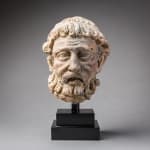Gandharan Stucco Head, 100 CE - 400 CE
stucco
height 16.5 cm
height 6 1/2 in
height 6 1/2 in
AM.0227
Further images
Mid-tan stucco head in the form of an older male with traces of original slip remaining. Gaunt, narrow face framed by beard and full head of thick curls; furrowed brow,...
Mid-tan stucco head in the form of an older male with traces of original slip remaining. Gaunt, narrow face framed by beard and full head of thick curls; furrowed brow, high cheekbones and beak nose present a distinct and expressive physiognomy that recalls Graeco-Roman prototypes rather than traditional Gandharan styles. Gandhara is an ancient kingdom that today denotes northern Pakistan and northeast Afghanistan. Situated at a confluence of trading routes along the Silk Road, Gandhara was a melting pot of different cultures and we see a vast array of influences in art - Hindu, Greco-Buddhist, Jewish and Parsi. After the conquests of Alexander the Great during 4th Century BC, we see a spread of Greek influence throughout the subcontinent. By 2nd Century AD, Gandhara had become the holy land of Buddhism. By 3rd Century AD, the empire came under Sassanid rule. Each successive culture left their imprint in art. Asceticism is advocated in many religious traditions such as Islam, Hinduism and Buddhism however fasting and mortification are strictly forbidden in Zoroastrianism, the official religion of the Sassanid Empire. Overriding the conflicting strictures of the dominant religions, this piece presents an interesting juxtaposition between a Buddhist tenet and Greco-Roman aesthetic.
Condition: Excellent; repaired from two parts.
Condition: Excellent; repaired from two parts.







